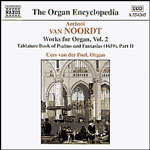
Van Noordt: Works for organ Vol 2
 $25.00
Low Stock
add to cart
$25.00
Low Stock
add to cart
ANTHONI van NOORDT
Van Noordt: Works for organ Vol 2
Cees van der Poel (organ)
[ Naxos Organ Encyclopedia / CD ]
Release Date: Saturday 1 May 2004
Should this item be out of stock at the time of your order, we would expect to be able to supply it to you within 2 - 5 business days.
"The playing is stylistically intelligent and seems exemplary. This disc, at budget price, surely merits the highest recommendation."
- Organists' Review (Michael Overbury), February 2000
By the mid-seventeenth century in Amsterdam the Dutch Golden Age was at its height. For many decades the city was considered the trading centre of the world. Culturally Amsterdam also had much to offer. It was the home of artists such as Rembrandt van Rijn, Joost van den Vondel and Jacob van Campen who enjoyed national fame. In this society the many churches of the city fulfilled an important social and religious function and city organists were held in high esteem. One Dutch city tried to outdo another by inviting famous organ-builders to construct beautiful instruments in the city churches and in Amsterdam the Old Church (Oude Kerk) and New Church (Nieuwe Kerk) had four important organs, built and funded by the city council.
In 1652 the organist Dirk Janszoon Sweelinck, the son and successor in the Old Church of the famous Jan Pieterszoon Sweelinck, died. After his death, the brothers Jacob and Anthoni van Noordt became the most important organists in Amsterdam. Anthoni was, from 1652, organist of the Nieuwe-Zijds-Kapel and was promoted to a similar position at the New Church in 1664. His elder brother Jacob succeeded Dirk Sweelinck in 1652 as organist of the Old Church. Here they were in the service of the city council and their only task was to give public recitals, since the organ remained silent during services.
In 1659 an important treatise by Constantijn Huygens was published in Amsterdam, Gebruyck of Ongebruyck van 't Orgel in de kercken der Vereenighde Nederlanden (The Use and Non-use of the Organ in the Churches of the United Netherlands). This had already appeared in The Hague in 1641. The work was a warning, addressed to the magistrates, drawing their attention to the poor state of congregational singing in Holland. In 1619 the Synod of Dordrecht had declared that only Genevan psalms were to be sung during the services. At the same time the Synod forbade the accompaniment of the psalms by the organ, leaving good church-goers to sing melodies they barely knew without instrumental support. The result was, according to Huygens, "an ugly snoring sound [which] sounded more like howling or screaming than human singing". He proposed the introduction of organ accompaniment for the psalms. This practice, however, was strictly forbidden in Amsterdam until 1680.
The magistrates of Amsterdam were well aware of the problems indicated by Huygens and gave orders for the municipal organists and carillonists to play generally improvised psalm variations in their recitals, to make the melodies more familiar. At the same time the magistrates stimulated an important change in the method of organ-building. From the middle of the seventeenth century old organs were, at the expense of the city council, supplied with many solo stops with which the new psalm melodies could be clearly heard. This introduced the so-called educative type of organ, developed to improve the then poor state of congregational singing.
In the same year, 1659, on 9th December, Anthoni van Noordt published his Tabulatuur-boeck van psalmen en fantasyen (Tablature Book with Psalms and Fantasias). Some psalm verses and the six fugal fantasias in canzona alla francese style had been written many years before, but a considerable part of the collection had been newly composed, in accordance with the orders of the city council. Research by Dr. Hans van Nieuwkoop (published in The Organ Yearbook 1990 (Vol. XXI), p. 35ff) has made it clear that in 1659 the pieces in the Tabulatuur-boeck could only have been played on the little organ in the Old Church. On all the other organs in Amsterdam, even on van Noordt's own instrument at the Nieuwe-Zijds-Kapel, the keyboard range necessary in van Noordt's works made performance of these pieces impossible.
As the first instrument in Amsterdam, the little organ of the Old Church was enlarged by the German organ-builder Hans Wolff Schonat by the addition of some new solo stops in 1657, two years before van Noordt's publication. The pedals had a Bourdon 16, an Octaaf 8 and a Trompet 8, suitable for solos and for the independent use of the pedals. According to the city chroniclers, the instrument was well known because of the daily recitals and in 1659 it was without doubt the most advanced instrument of its kind in Amsterdam. The Tabulatuur-boeck exactly matched the possibilities of the newly enlarged instrument in the Old Church and met the wishes of the magistrates. van Noordt provided many psalm verses with a cantus firmus, a technique that aptly demonstrated the new solo stops and unknown psalm melodies. It is therefore probably no accident that the publication of the Tabulatuur-boeck coincided with that of the treatise by Huygens. Both dedicated their works to the city council. It is clear that van Noordt, in his compositions, took into consideration the organ of the Old Church, which set an example for future organ-building.
Tracks:
Fantasia No. 2
Psalm L (4 verses)
Psalm CXIX (8 verses)
Fantasia No. 4
Psalm XXXVIII
Fantasia No. 5
Psalm CXVI

![Das Orgelbuchlein [Little Organ Book] Vol. 1 cover](https://images.marbecks.co.nz/_thumbnails/10131/10131504.jpg)